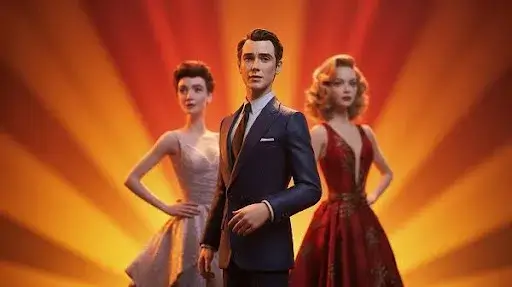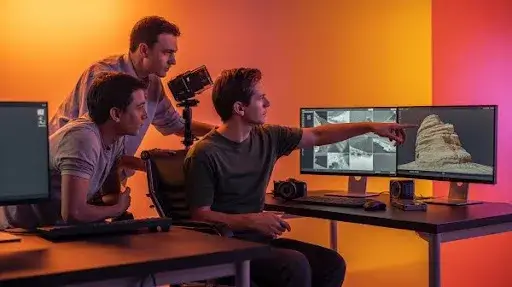3D animation doesn’t just tell stories — it makes them feel alive. Think of the moment a T-Rex roared in Jurassic Park, or the first time Woody and Buzz argued in Toy Story. Those scenes changed what audiences believed was possible on screen.
But none of this happened overnight. The history of 3D animation is a messy, fascinating timeline. It starts with experiments that looked more like science projects than art, then shifts into Hollywood spectacle, and now stretches into gaming, advertising, and even classrooms. What began as tiny tests in labs grew into an animation industry worth billions.
Fact: The worldwide market for 3D animation software was estimated at $25.16 billion in 2024 and is projected to expand to $64.37 billion by 2033, reflecting a CAGR of 6.4% throughout the forecast timeframe.
The Beginnings of Animation
Before computers entered the picture, animation was all hands-on. Artists drew every single frame, or they used clay models to fake motion. In the early 1900s, claymation started making noise. A figure was sculpted, shifted a fraction, photographed, then shifted again. Over and over, until motion appeared on screen.
It worked, but at a cost. Films like The Sculptor’s Welsh Rarebit Dream (1908) proved claymation could create depth, yet the process was painfully slow. Clay cracked, figures broke, and the patience required scared off most studios. Still, it planted an idea: movement didn’t have to stay flat. There was room for something richer — and one day, computers would fill that gap.
Early Experiments with 3D Animation Technology
By the 1960s, engineers started pushing computers beyond crunching numbers. William Fetter at Boeing sketched out a computerized pilot known as the “Boeing Man.” It wasn’t for entertainment, but it showed a big step forward: computers could mimic human form and posture.
A few years later, Frederic Parke created a digital face that could smile, blink, and frown. Around the same time, Edwin Catmull — who would later co-found Pixar — designed a moving digital hand. Looking back, those early clips feel clunky. But at the time, they were revolutionary.
What mattered wasn’t the polish. It was the proof. If a hand and a face could be built inside a computer, the feasibility of 3D animation in Hollywood was no longer a dream.
The Re-emergence of 3D Animation in Film
Then came 1976. Futureworld premiered, and for the first time moviegoers saw computer-generated animation on the big screen. A hand and a face appeared — Catmull and Parke’s creations. Short, sure. But unforgettable.
Hollywood paid attention. By 1977, George Lucas was already leaning on computer graphics to bring Star Wars: A New Hope to life. Then in 1982, Tron went further. It didn’t just sprinkle in effects — the entire film leaned into computer imagery. For audiences, it was like stepping into another reality.
This wasn’t just tech flexing. It was storytelling shifting gears. Studios realized people were ready to accept stories where computers helped drive the visuals.
The Technology That Pushed the Industry Forward
The 1980s were a playground for new tools. J. Turner Whitted introduced recursive ray tracing, which allowed light to bounce, reflect, and cast shadows in realistic ways. Suddenly, shiny surfaces looked like shiny surfaces.
Then Autodesk dropped AutoCAD in 1982. At first it was aimed at architects, but animators grabbed it too. It made digital modeling and design more practical. Artists weren’t just drawing anymore — they were coding, sculpting, and experimenting with machines.
By the end of the decade, 3D animation technology was no longer a novelty. It was a growing craft with clear potential, and Hollywood couldn’t ignore it.
Hollywood’s Love Affair with Computer-Generated 3D Animation
The 1990s lit the fuse. Directors dove headfirst into computer-generated 3D animation, and the results blew audiences away.
Terminator 2: Judgment Day (1991) introduced the liquid metal T-1000. A villain that could morph into anyone and survive anything — impossible to shoot with practical effects. Then came Jurassic Park (1993). Dinosaurs that moved, breathed, and looked terrifyingly real. People walked out of theaters asking the same thing: how did they pull that off?
For the first time, 3D animation wasn’t just an enhancement. It was the headline act.
The First 3D Animation Movie
1995 marked the real breakthrough. Pixar dropped Toy Story, the first full-length film built entirely with computer-generated animation. It wasn’t just a tech demo. It had heart, humor, and a story that worked for kids and adults alike.
The box office numbers told the story — $360 million worldwide. Pixar went from a small studio to a household name almost overnight. And every other studio took notes.
Soon DreamWorks answered with Shrek. Disney leaned into films like Frozen years later. The race for high quality 3D video animation services was in full swing, and the rise for 3D animation was impossible to stop.
The Animation Industry at the Turn of the Century
By the late 90s and early 2000s, the shift was locked in. George Lucas doubled down, filling the Star Wars prequels with digital characters and sets. Even live-action films that didn’t scream “animated” were sneaking in CGI at every turn.
Then James Cameron changed the game again in 2009. Avatar wasn’t just a movie — it was a milestone. From its glowing alien forests to the lifelike Na’vi, it showed the sheer scale 3D animation could handle.
By then, the 3D animation industry wasn’t just thriving in Hollywood. It had spread to gaming, television, advertising, and corporate projects. The technology had gone from experimental to essential.
Everyday Impact of 3D Animation Technology
When people hear “3D animation,” they often think of kids’ films — Frozen, Zootopia, Sing. But the reach is much wider. Look at Dune, Tenet, or any Marvel release. Nearly every blockbuster uses computer-generated 3D animation in ways audiences don’t even notice.
Explosions, collapsing buildings, futuristic cities — much of it is digital. And because it blends so well, most people leave the theater never realizing how much was created on a computer.
Outside Hollywood, the style of animation drives video games, powers virtual reality, and gives businesses tools for product demos or training. High quality 3D video animation services are no longer an option. For many industries, they’re a necessity.
A Constant Push Toward Realism
What started as blocky hands and stiff faces now feels almost human. Complex facial animations, powered by motion capture, let characters raise eyebrows, smirk, or tear up in ways that tug at emotions.
Look at Avatar or The Last of Us Part II. Digital characters show expressions so detailed it’s easy to forget they aren’t flesh and blood. And studios keep chasing more. Photorealism, 4D animation, even AI-driven workflows are shaping the next chapter in the future of 3D animation.
The Expansion of the 3D Animation Industry
Once Hollywood proved computer graphics could wow an audience, the rest of the world piled on. TV was quick to experiment. If you grew up in the late ’90s or early 2000s, you probably remember ReBoot or Jimmy Neutron. Looking back, the characters feel clunky and plastic. At the time? It was like catching a glimpse of tomorrow during Saturday morning cartoons.
Video games weren’t far behind. The first 3D attempts looked rough — blocky heads, stiff arms, worlds that felt more like cardboard cutouts. But the pace of improvement was wild.
By the PlayStation 2 and Xbox years, those flat backdrops had turned into buzzing cities and believable forests. What had once belonged only in big-budget films was suddenly running on home consoles.
And then businesses jumped in. Sneakers twirling in midair for ads. Cars shown in glossy digital form before the first prototype existed. Training clips that looked more like mini-movies than instruction manuals. 3D had moved from “fun experiment” to everyday selling tool.
How 3D Animation Changed Hollywood
For filmmakers, 3D wasn’t just flashy — it solved headaches. Building massive sets, paying crews to reset props, or burning money on reshoots? All of that could be sidestepped with digital production.
Think about The Matrix in 1999. That bullet-time scene where Neo bends backward and the world slows down wasn’t just eye candy. It showed that digital techniques could flip the language of cinema on its head.
Directors suddenly had room to play. Want to adjust the lighting? A few clicks. Resize a prop? Done. Rebuild a sequence without calling back the actors? Possible. What once ate budgets became a creative playground instead.
The 2000s: When 3D Took Over
By the early 2000s, the question wasn’t if studios would use 3D — it was how much. Audiences had already bought in. Finding Nemo, Shrek 2, The Incredibles — these weren’t just box-office smashes. They became part of everyday culture.
Motion capture, too, started to dominate. Gollum in The Lord of the Rings wasn’t just a sidekick; he proved digital characters could feel disturbingly human. On TV, 2D and 3D blended into playful hybrids, while games like Halo and Grand Theft Auto raised the bar for immersion.
By then, 3D animation studios weren’t outsiders anymore. They were running the show.
The Future of 3D in Everyday Life
Today, 3D isn’t tucked away in theaters — it’s everywhere. Medical students test-drive surgeries on digital patients. Architects let clients “walk” through a building that only exists on a screen. Teachers design lessons in classrooms made entirely of pixels. What once looked experimental has become part of daily life.
And the tools keep getting sharper. AI cuts production time. Motion capture tracks the tiniest flick of an eyebrow. Real-time rendering means an animator can tweak a scene instantly instead of waiting all night.
Then there’s AR and VR. Slip on a headset and you could be job training, house-hunting, or playing in a fully digital world. Immersive experiences aren’t “coming soon” — they’re already here, and demand is only rising.
Styles of Animation: Then vs. Now
The shift in style is staggering. Early 3D looked like dolls with frozen smiles and rubbery arms.
Now? Watch Avatar: The Way of Water or Disney’s remake of The Lion King and you’ll forget you’re not looking at reality. Water ripples with weight, fur moves in the wind, and digital faces convey feelings that hit you in the gut.
But realism isn’t the only route. Some animators chase the surreal instead: bold palettes, dreamlike landscapes, and exaggerated designs. That tension between realism and imagination keeps the artform alive.
Frequently Asked Questions
What was the first fully 3D animated movie?
Pixar’s Toy Story (1995). Some films toyed with 3D before, but this was the first feature built entirely with it.
Why did 3D take off so quickly?
Because it made the impossible believable — from the dinosaurs in Jurassic Park to toys coming alive in Toy Story.
Is 3D only for movies?
No. Today, 3D video animation services are everywhere: advertising, gaming, medicine, education, even construction.
How is 3D different from traditional animation?
Traditional methods mean redrawing every frame. With 3D, you build a digital model once and then reuse it with different lights, movements, and camera angles.
What’s next for 3D animation?
Faster workflows (thanks to AI), hyper-real visuals, and bigger roles in AR and VR. It’s already changing how people shop, learn, and connect.
Final Words
The rise of 3D animation shows one thing: it isn’t fading. From blocky beginnings to near-photorealistic worlds, it’s reshaped entertainment, advertising, education, and more.
For brands, that matters. Flat images aren’t enough. People want depth, motion, and storytelling that feels alive. That’s where professional 3D video animation services come in.
At Prolific Studio, one of the best animation studios in Florida, we bring those ideas to life. Whether it’s a product demo, marketing campaign, or training video, animation is more than decoration — it’s a way to connect. The future of animation isn’t waiting around the corner. It’s already here. The question is: are you ready?










